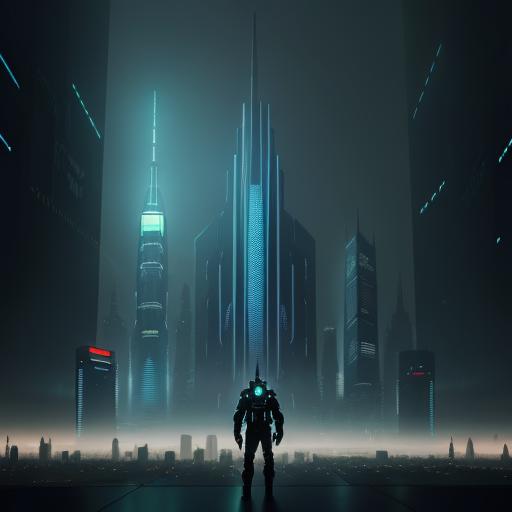Ever wondered how computers can create amazing artwork? Welcome to the exciting world of AI art generation! Whether you’re an artist looking to try new tools or just someone curious about digital creativity, this guide will show you everything you need to know about making art with artificial intelligence.
Podcast about Creating Digital Art with Artificial Intelligence
Listen of download!
- Podcast about Creating Digital Art with Artificial Intelligence
- The Evolution of Computer-Generated Art: From Pixels to Masterpieces
- Text-to-Image AI Models
- Neural Style Transfer: The Digital Art Chameleon
- DALL-E 2 vs. Midjourney vs. Stable Diffusion: The Big Three Compared
- More Cool AI Art Tools You Should Know About
- Writing Better Prompts (The Secret Sauce!)
- Fixing Common Problems
- Use our Tool to Create your Prompts
- For Business
- For Creative Projects
- Cool New Tech on the Horizon
- AI and Traditional Art Coming Together
- Step 1: Pick Your First Tool
- Step 2: Start Simple
- Step 3: Level Up Your Skills
- Legal Things to Think About
- Being a Good AI Artist
- Where to Learn More
- Tools You Might Need
- Want to Learn More?
What Is Generative AI Art? Understanding the Digital Art Revolution
Think of AI art as having a super-smart digital assistant that can help you create artwork. Just like how a human artist learns by studying other artworks, AI art tools learn from millions of images to understand how to create new ones. It’s changing how we make art, kind of like how digital cameras changed photography!
The Evolution of Computer-Generated Art: From Pixels to Masterpieces
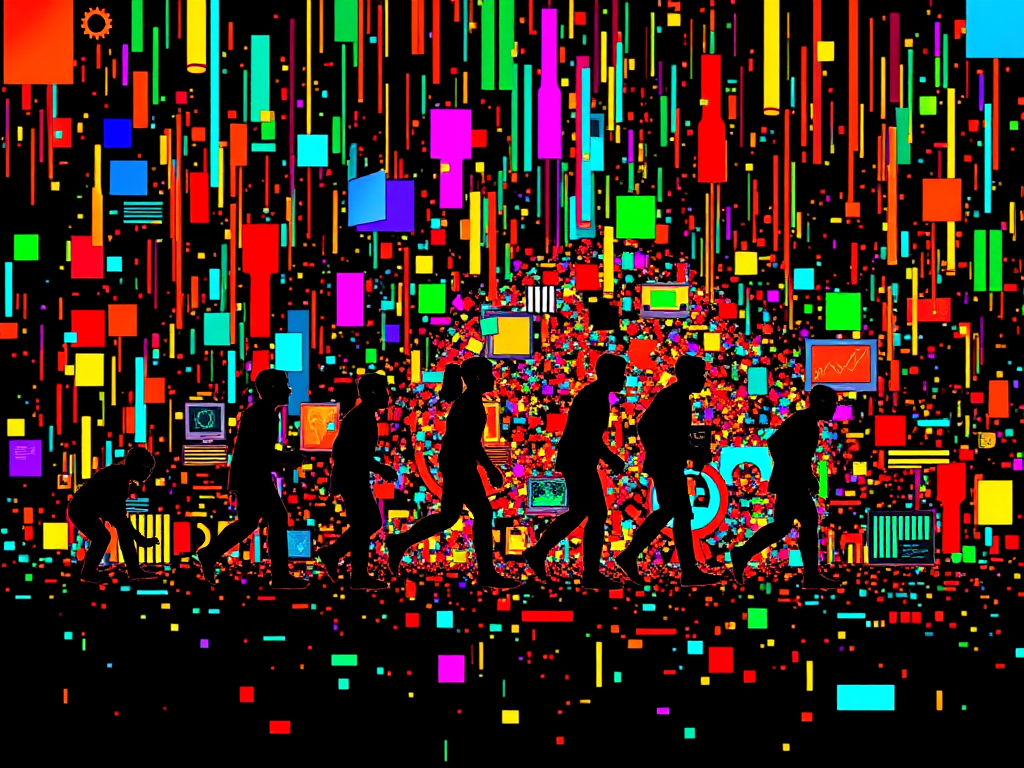
Early Digital Art Pioneers (1950s-2000s)
Want to know where AI art really began? Let’s look at the pioneers who started it all:
- Harold Cohen’s AARON program (1973): Picture a computer program that could actually draw and paint on its own – that was AARON! Cohen, a professional artist turned programmer, created this groundbreaking system that could make independent decisions about composition, color, and form. AARON even had its own art exhibitions, making people wonder if computers could really be creative.
- Manfred Mohr’s algorithmic art exhibitions (1971): Mohr was like a mathematician with an artist’s soul. He used early computers to create fascinating geometric designs based on mathematical rules (algorithms). His first major computer art exhibition at the Musée d’Art Moderne in Paris shocked the art world and showed that computers could create beautiful, meaningful art.
- Vera Molnar’s computer-generated geometric abstractions (1968): This amazing artist used an early computer to create beautiful patterns and shapes. Think of it like having a super-precise assistant who could draw perfect lines and shapes millions of times! Molnar’s work proved that computers could help artists explore new creative possibilities that would be impossible by hand.
The Machine Learning Revolution (2014-Present)
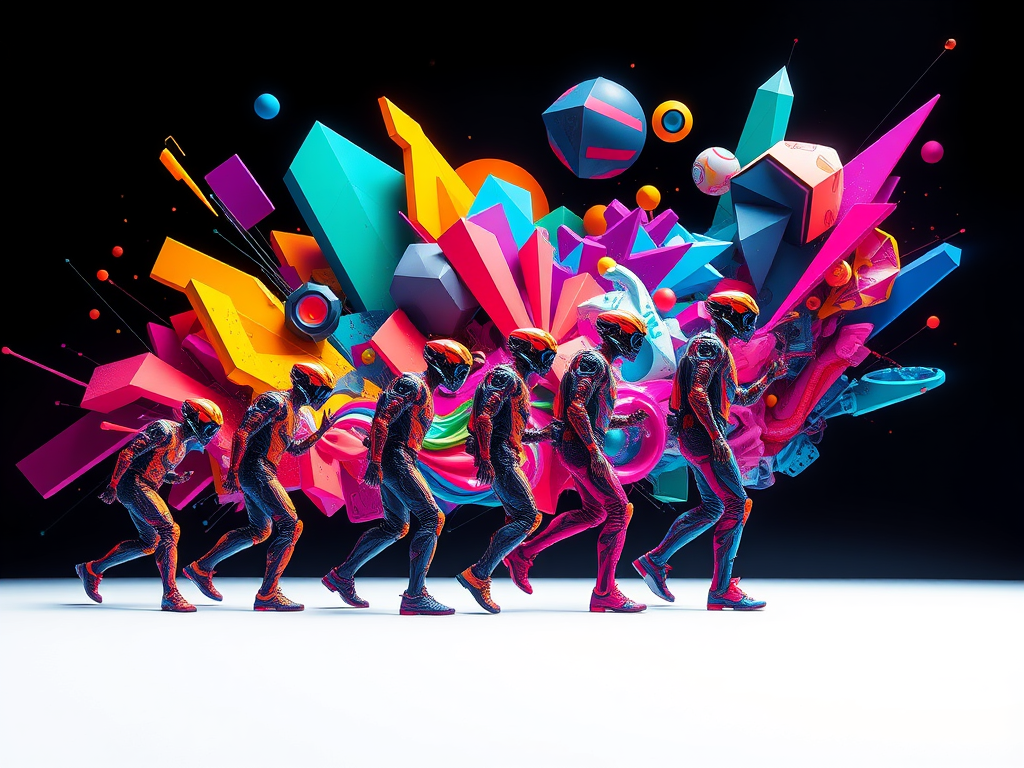
The real AI art boom happened when machine learning entered the picture. Here’s what changed everything:
- Ian Goodfellow’s introduction of GANs (Generative Adversarial Networks): Imagine two AIs playing an endless game of “spot the fake.” One AI creates images, while the other tries to guess if they’re real or artificial. Through this back-and-forth competition, they both get better and better at their jobs. This breakthrough in 2014 made it possible for AI to create amazingly realistic images.
- DeepDream by Google: Remember those trippy, dream-like images that flooded the internet in 2015? That was DeepDream! Google engineers created this tool that could find and enhance patterns in images, turning ordinary photos into psychedelic artwork filled with dog faces and swirling patterns. It was the first time AI art caught the public’s imagination and went truly viral.
- The landmark Christie’s auction of “Portrait of Edmond Belamy” ($432,500): In 2018, a blurry portrait created by AI sold for nearly half a million dollars at Christie’s auction house. It was created by a collective called Obvious Art using GANs, and the sale shocked the art world. This wasn’t just a tech demonstration anymore – AI art had officially entered the fine art market!
How AI Art Generation Actually Works
Let’s break down how these amazing tools create art, without getting too technical:
Text-to-Image AI Models
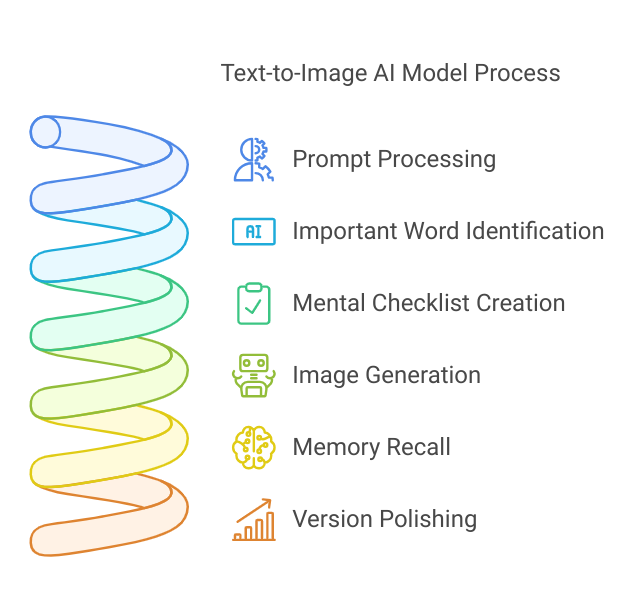
It’s like having a super-smart artist who listens to your description and draws exactly what you describe:
Prompt Processing
- First, the AI reads your description carefully, just like an artist would listen to a client
- It picks out important words about style, objects, and composition
- Think of it as making a mental checklist of everything you want in the image
Image Generation
- The AI looks through its “memory” of millions of images it’s learned from
- It starts creating multiple versions, like an artist making rough sketches
- Finally, it polishes the best version to match what you asked for
Neural Style Transfer: The Digital Art Chameleon
This is like having a magical paintbrush that can copy any artist’s style:
- Takes your regular photo and analyzes what makes it unique
- Studies the style of famous artworks you choose
- Combines them to create something new and exciting
- Use AI to analyse paintings for amazing insights
Today’s Most Popular AI Art Tools
DALL-E 2 vs. Midjourney vs. Stable Diffusion: The Big Three Compared
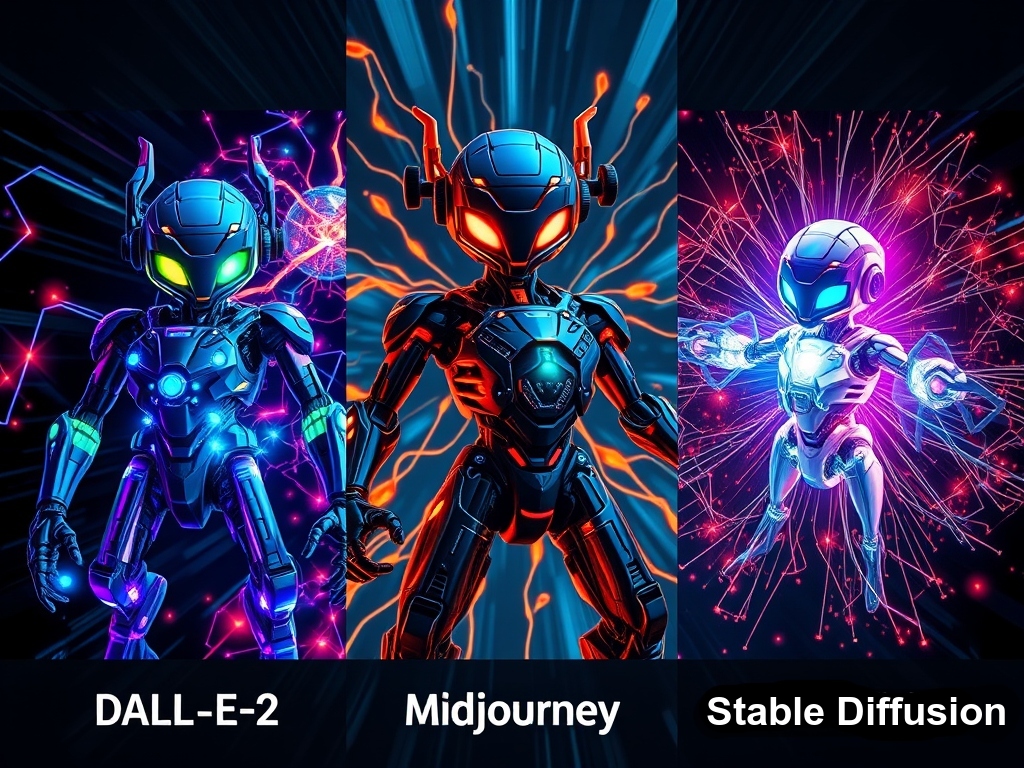
Think of these like different types of art studios, each with its own specialty:
DALL-E 2
- Best for: Beginners and realistic images
- Cool feature: Can edit existing images
- Price: Starts free, then pay-per-image
- Think of it as: The friendly neighborhood art studio
Midjourney
- Best for: Artistic, fantastical images
- Cool feature: Amazing lighting and composition
- Price: Monthly subscription
- Think of it as: The professional artist’s workshop
Stable Diffusion
- Best for: Tech-savvy users who like to tinker
- Cool feature: Can run it on your own computer
- Price: Free (if you run it yourself)
- Think of it as: Your personal art laboratory
More Cool AI Art Tools You Should Know About
Artbreeder
- Perfect for: Portrait generation and image mixing
- Unique feature: Genetic breeding of images
Think of Artbreeder as a digital art laboratory where you can mix and match different images like a DJ mixes music. Want to combine a lion with a sunset? Or merge different faces to create a unique character? Artbreeder lets you do this with its “genetic breeding” feature. You can even adjust specific features like age, smile, or hair color with simple sliders.
RunwayML
- Perfect for: Video editing and motion graphics
- Standout capability: AI-powered video generation
Imagine having a video editor that can remove backgrounds, generate new scenes, or even create simple animations from text descriptions. That’s RunwayML! It’s like having a mini Hollywood studio on your computer. You can turn still images into moving videos, change the style of your footage, or even create custom visual effects without needing years of experience.
Deep Art Effects
- Ideal for: Photo-to-artwork conversion
- Specializes in: Classical art style transfer
Ever wondered what you’d look like in a Van Gogh painting? Deep Art Effects can transform your regular photos into artwork that looks like it was created by famous artists. It’s not just a simple filter – the AI actually understands artistic styles and can apply them intelligently to your images. You can turn vacation photos into impressionist masterpieces or selfies into Renaissance portraits!
Pro Tips for Better AI Art
Writing Better Prompts (The Secret Sauce!)
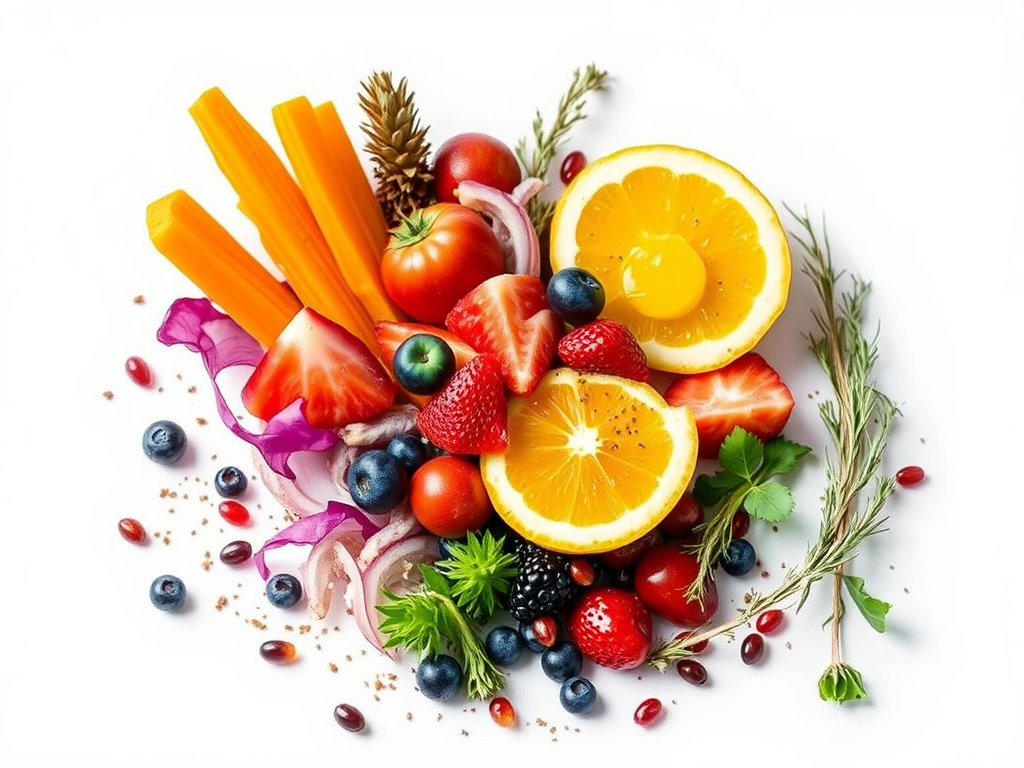
Think of prompts as recipes for your AI art (this link specific prompts and their construction). Here’s how to make them great:
Be Super Specific
- Instead of: “a beautiful landscape”
- Try: “a misty mountain valley at sunrise, painted in watercolor style, with golden light streaming through pine trees”
Add Style Details
- Mention artists: “in the style of Monet”
- Add art techniques: “oil painting,” “pencil sketch”
- Include mood: “dreamy,” “dramatic,” “peaceful”
Use Power Words
- Quality boosters: “highly detailed,” “masterpiece”
- Technical terms: “8K resolution,” “photorealistic”
- Lighting: “golden hour,” “dramatic shadows”
Fixing Common Problems
Problem: Blurry or Weird Images
- Solution: Use words like “sharp,” “detailed,” “clear”
- Add: “high resolution,” “4K,” “masterpiece”
- Example: Instead of “a cat,” try “a highly detailed portrait of a cat, sharp focus, studio lighting”
Problem: Wrong Style
- Solution: Be specific about the art style you want
- Mention specific artists or art movements
- Example: Instead of “painting,” try “oil painting in the style of Vincent van Gogh”
Problem: Weird Hands or Faces
- Solution: Add extra details about these features
- Use words like “anatomically correct”
- Example: “portrait with realistic facial features, detailed eyes, natural hands”
Use our Tool to Create your Prompts
Prompts made easy – use our free tool below – just click on image
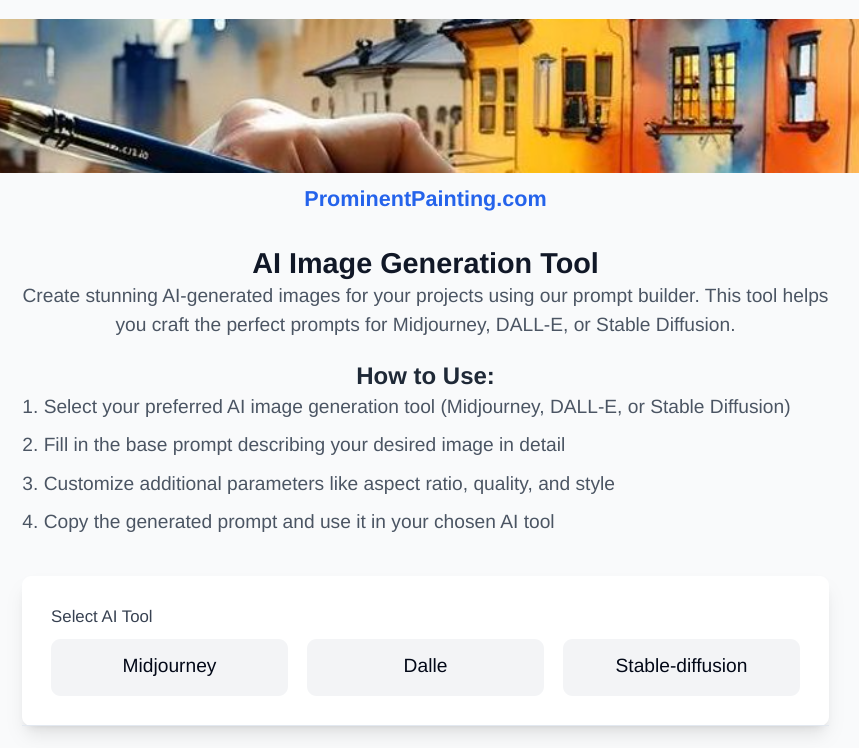
Cool Ways People Are Using AI Art
For Business
Advertising and Marketing
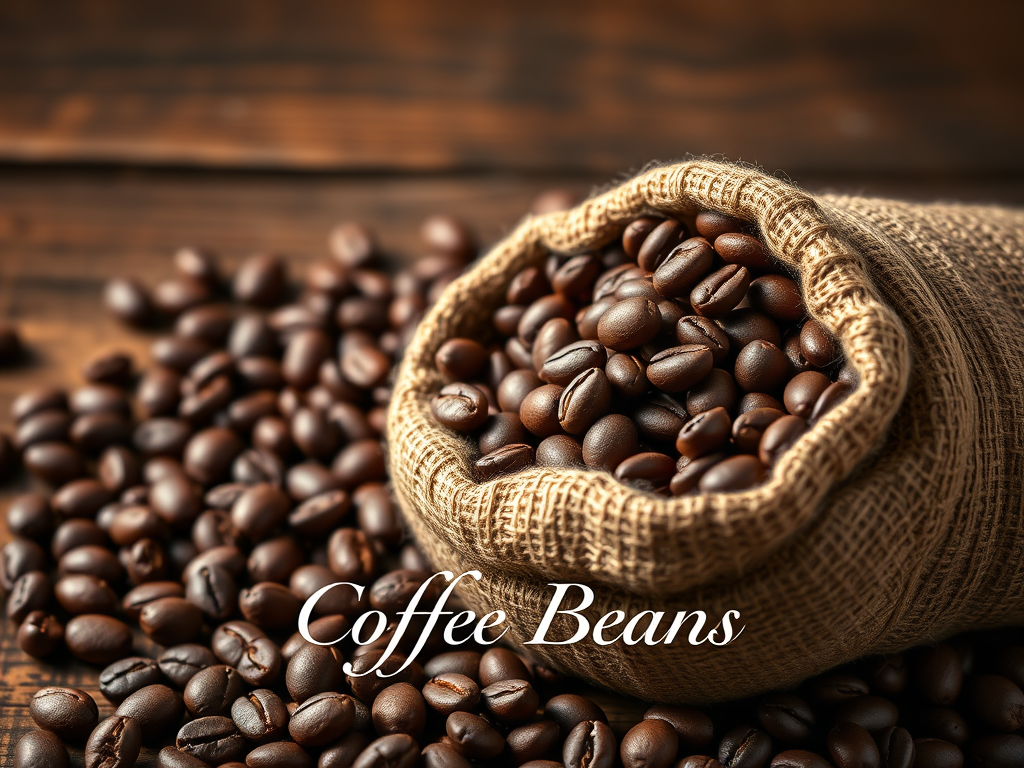
- Making quick mockups for ads
- Creating social media posts
- Designing custom product images
Example: A coffee shop using AI to create beautiful menu designs and Instagram posts
Game Development
- Designing character concepts
- Creating game environments
- Making texture patterns
Example: An indie game developer using AI to create different alien landscapes
Book Publishing
- Designing eye-catching covers
- Making chapter illustrations
- Creating marketing materials
Example: A self-published author using AI to design a professional-looking book cover
For Creative Projects
Artists and Designers
- Getting inspiration for new ideas
- Creating quick concept sketches
- Exploring different styles
Example: A graphic designer using AI to brainstorm logo ideas
Content Creators
- Making YouTube thumbnails
- Creating blog post images
- Designing social media graphics
Example: A YouTuber using AI to create attention-grabbing thumbnail images
What’s Coming Next in AI Art?
Cool New Tech on the Horizon
3D AI Art
- Creating 3D models from descriptions
- Designing virtual reality spaces
- Making animated characters
Example: Imagine describing a character and watching it come to life in 3D!
Interactive Art
- Art that changes based on viewer movement
- Collaborative AI-human artworks
- Real-time art generation
Example: A museum display that creates art based on how visitors move
AI and Traditional Art Coming Together
- Digital tools helping with traditional painting
- Mixed reality art exhibitions
- AI assistants for artists
Example: An artist using AI to sketch ideas before painting them by hand
Getting Started: Your First AI Artwork
So it’s time to create your first AI masterpiece
Step 1: Pick Your First Tool
Choose something easy to start with:
- DALL-E 2 is great for beginners
- Midjourney if you want artistic results
- Stable Diffusion if you like tech stuff
Step 2: Start Simple
- Try basic prompts first
- Learn from what works
- Save your favorite results
Step 3: Level Up Your Skills
- Join online communities
- Learn from others
- Practice different styles
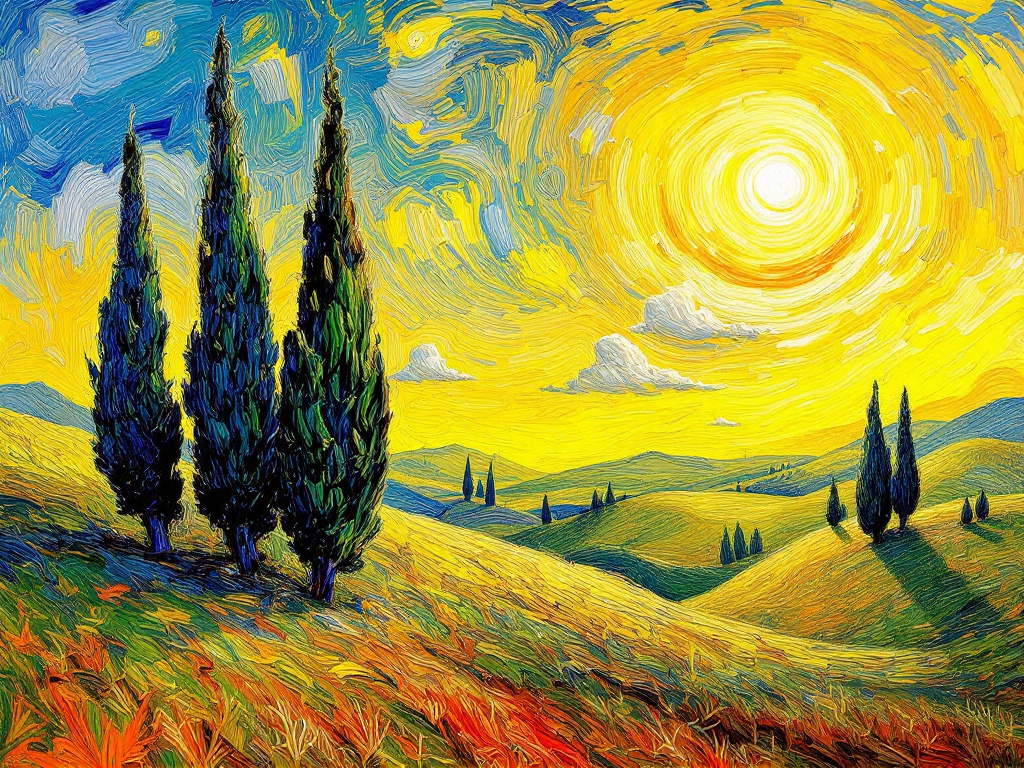
Important Stuff to Know
Legal Things to Think About
- Check if you can sell your AI art
- Learn about image rights
- Understand what’s okay to create
Being a Good AI Artist
- Give credit to the AI tools you use
- Be honest about how you make your art
- Respect other artists’ work
Helpful Resources
Where to Learn More
Online Learning
Places to Share Your Art
Tools You Might Need
Prompt Help
Extra Software
Wrapping It Up
AI art is super exciting and getting better all the time! Whether you want to make cool images for fun, help with your business, or explore new creative ideas, there’s never been a better time to start. Remember, the best way to learn is to jump in and start creating – you might be surprised at what you can make!
[Editor’s Note: We update this guide regularly to keep up with new AI art tools and techniques. Last updated: December 2024]
Want to Learn More?
- Check out our other AI art guides
- Join our community
- Share your creations
- Ask questions and get help
Remember, every artist started somewhere – even AI artists! So don’t be afraid to experiment and have fun with it. Who knows? Your next AI masterpiece might be just a prompt away!



